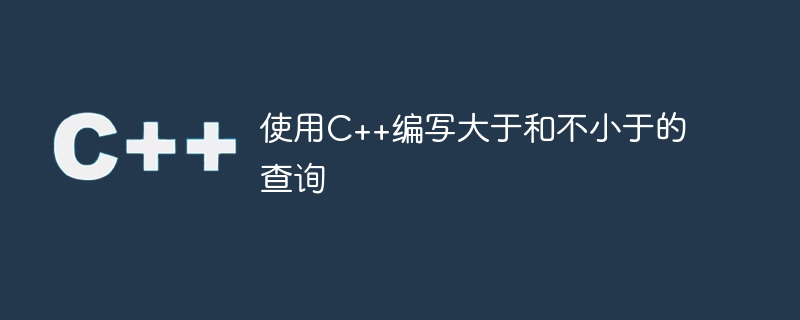
在这篇文章中,我们被给定了一个问题,给定了一个数组,并且有两种类型的查询需要回答。
- 类型 0 - 我们需要计算大于等于 x(给定值)的元素的数量。
- 类型 1 - 我们需要计算严格大于 x(给定值)的元素的数量。
所以这里有一个简单的例子 -
'Input : arr[] = { 10, 15, 30 , 40, 45 } and Q = 3
Query 1: 0 50
Query 2: 1 40
Query 3: 0 30
Output :
0
1
3
Explanation:
x = 50, q = 0 : No elements greater than or equal to 50.
x = 40, q = 1 : 45 is greater than 40.
x = 30, q = 0 : three elements 30, 40, 45 are greater than or equal to 30.找到解决方案的方法
我们可以使用两种不同的方法来找到解决方案。首先,我们将使用暴力解决方案,然后检查它是否适用于更高的约束条件。如果不适用,则我们继续优化我们的解决方案。
暴力解决方案
在这种方法中,我们将遍历数组以满足给定条件的所有q个查询,并找到满足条件的数字。
示例
'#include <bits/stdc++.h>
using namespace std;
void query(int *arr, int n, int type, int val) {
int count = 0; // answer
if(!type) { // when type 0 query is asked
for(int i = 0; i < n; i++) {
if(arr[i] >= val)
count++;
}
} else { // when type 1 query is asked
for(int i = 0; i < n; i++) {
if(arr[i] > val)
count++;
}
}
cout << count << "n";
}
int main() {
int ARR[] = { 10, 15, 30, 40, 45 };
int n = sizeof(ARR)/sizeof(ARR[0]); // size of our array
query(ARR, n, 0, 50); // query 1
query(ARR, n, 1, 40); // query 2
query(ARR, n, 0, 30); // query 3
return 0;
}输出
'0
1
3在上述方法中,我们只是遍历数组并计算查询的答案;这种方法对于给定的示例是有效的,但如果遇到更高的约束条件,这种方法将失败,因为程序的总时间复杂度是O(N*Q),其中N是数组的大小,Q是查询的数量,所以现在我们将优化这种方法,使其适用于更高的约束条件。
高效的方法
在这种方法中,我们将使用二分查找来找到给定值的上界和下界。我们首先使用二分查找对数组进行排序,然后根据需要应用我们的下界和上界函数。
示例
'#include <bits/stdc++.h>
using namespace std;
void lowerbound(int *arr, int n, int val) {
int l = -1, r = n;
while(r - l > 1) { // binary searching the answer
int mid = (l+r)/2;
if(arr[mid] >= val)
r = mid;
else
l = mid;
}
if(r == n) // if r is unmoved then it means there is no element that satisfy the condition
cout << "0n";
else
cout << n - r << "n";
}
void upperbound(int *arr, int n, int val) {
int l = -1, r = n;
while(r - l > 1) { // binary searching the answer
int mid = (l+r)/2;
if(arr[mid] > val)
r = mid;
else
l = mid;
}
if(r == n)// if r is unmoved then it means there is no element that satisfy the condition
cout << "0n";
else
cout << n - r <<"n";
}
void query(int *arr, int n, int type, int val) {
if(!type) // if type == 0 we call lower bound function
lowerbound(arr, n, val);
else // if type == 1 we call upperbound function
upperbound(arr, n, val);
}
int main() {
int arr[] = { 1, 2, 3, 4 };
int n = sizeof(arr)/sizeof(arr[0]); // size of our array
sort(arr, arr+n); // sorting the array
query(arr, n, 0, 5); // query 1
query(arr, n, 1, 3); // query 2
query(arr, n, 0, 3); // query 3
return 0;
}输出
'0
1
2上面的代码使用了二分搜索,大大减少了时间复杂度。因此,我们的最终复杂度为O(NlogN),其中N是数组的大小。
上述代码的解释
在这种方法中,我们将使用二分搜索来找到给定值的上界和下界。现在对于二分搜索,我们首先对数组进行排序,因为它只适用于排序后的数组。我们创建一个lower bound和一个upper bound函数,帮助我们找到满足类型0和类型1条件的第一个数字,现在我们已经对数组进行了排序。我们找到了满足条件的第一个数字,所以在这个元素之后的元素也满足条件,因此我们打印出该元素与N(数组的大小)的索引之差。
结论
在本文中,我们解决了使用二分搜索解决大于和不小于的查询问题。我们还学习了这个问题的C++程序以及我们解决这个问题的完整方法(普通和高效)。我们可以用其他语言(如C、Java、Python和其他语言)编写相同的程序。希望您觉得这篇文章有帮助。
